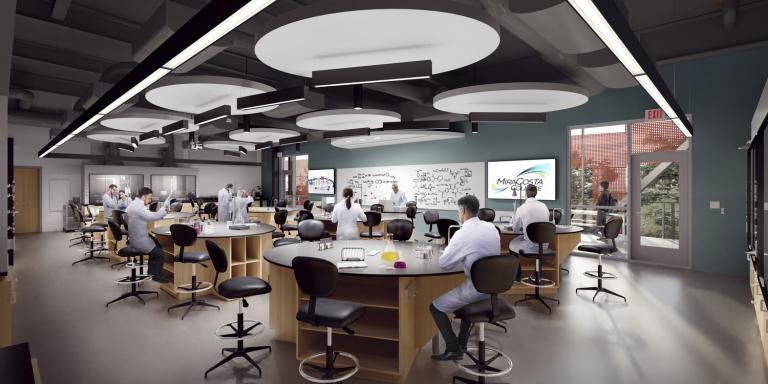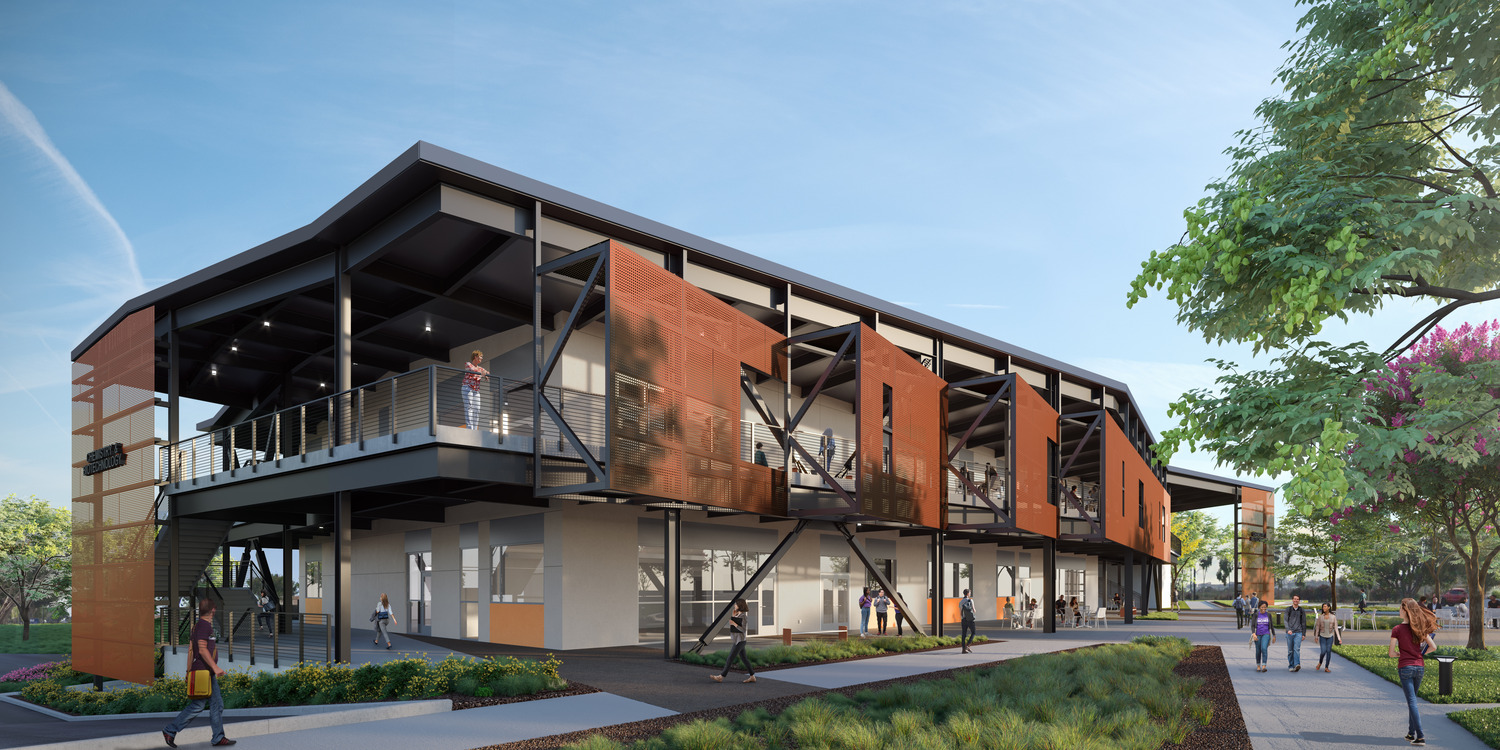
August 16, 2021
HED lab planner Marilee Lloyd sits down with Lab Manager to discuss the MiraCosta Community College Chemistry and Biotech Building project
MiraCosta Community College’s Chemistry and Biotech building is an up-to-date addition to the campus, with the intention to put “science on display” for the school community. The $37.4 million project was accomplished through a partnership between HED and C.W. Driver, and it features 24,000 square feet of STEM instructional space including new chemistry labs and 40-person, flexible classrooms.
To learn more about the project and its unique design, Lab Manager spoke with HED's Marilee Lloyd, AIA, laboratory planner. Below is an excerpt of their interview, you can read the full piece on Lab Manager's website using the link below.
Q: What was the need for this facility?
A: MiraCosta Community College (MCC) is seeking to advance the MiraCosta Community College District’s STEM curriculum to the next level with this facility's mix of instructional, work, social, and laboratory spaces. The building will support the growth of the existing biotechnology and chemistry programs, creating a learner-centered environment and supporting a new home for MCC’s new baccalaureate degree for this program. The learning spaces and exterior collaboration areas are activated through integration with the latest learning technology systems. This tangible and virtual instructional flexibility will benefit both students and faculty.
Q: What kinds of sustainability initiatives have been included in the design plan?
A: Sustainability is a vital part of the conversation for all projects at HED. The conversation starts early and continues as the design process evolves. A mixture of passive and active strategies is discussed, and at MCC, have been integrated into the design. The team is targeting LEED Silver for the building. The sunshades at the perimeter create both a sense of place and a focus for views, while also reducing glare at the interior and help shade the window glazing. Photovoltaics will be located on the roof, above the main exterior pathway through the building, connecting the campus. Additionally, smart occupancy-based lighting controls, fume hood controls and sash closers have also been designed to aid in reducing the carbon footprint of the building.
To learn more about the project and its unique design, Lab Manager spoke with HED's Marilee Lloyd, AIA, laboratory planner. Below is an excerpt of their interview, you can read the full piece on Lab Manager's website using the link below.
Q: What was the need for this facility?
A: MiraCosta Community College (MCC) is seeking to advance the MiraCosta Community College District’s STEM curriculum to the next level with this facility's mix of instructional, work, social, and laboratory spaces. The building will support the growth of the existing biotechnology and chemistry programs, creating a learner-centered environment and supporting a new home for MCC’s new baccalaureate degree for this program. The learning spaces and exterior collaboration areas are activated through integration with the latest learning technology systems. This tangible and virtual instructional flexibility will benefit both students and faculty.
Q: What kinds of sustainability initiatives have been included in the design plan?
A: Sustainability is a vital part of the conversation for all projects at HED. The conversation starts early and continues as the design process evolves. A mixture of passive and active strategies is discussed, and at MCC, have been integrated into the design. The team is targeting LEED Silver for the building. The sunshades at the perimeter create both a sense of place and a focus for views, while also reducing glare at the interior and help shade the window glazing. Photovoltaics will be located on the roof, above the main exterior pathway through the building, connecting the campus. Additionally, smart occupancy-based lighting controls, fume hood controls and sash closers have also been designed to aid in reducing the carbon footprint of the building.

Q: Is there anything particularly unique or ground-breaking about your facility or the design plan?
A: The tissue culture lab draws heavily on the layouts in actual research space. The goal of the design team was to create a space where students would experience equipment, tools, and an actual functional layout like the type they would likely encounter upon entering the workplace. The team took this approach toward the layout of the tissue culture lab. We used the module to establish the layout, and centralized the ancillary equipment (refrigerator, incubator stack) adjacent to the BSC (biological safety cabinet).
Daylighting the lab spaces as much as was possible and bringing the effects of the wonderful southern California climate into the learning environments were important to the entire design team. Too often access to daylight and views is sacrificed for the needs of equipment and the design to focus students on task. More recently, we are finding that the ability to see outside, is an important component in creating a dynamic learning space where students can take a moment, refocus, and return their work with sustained vigor. The faculty also looks forward to some study and collaboration to be able to spill outside the class laboratories, and into the adjacent exterior areas.
Additionally, the design team developed custom student workstations and instructor stations that reflect the needs of the learning environment. The arrangement responds to the instruments the students use, placing them near to hand to support a class session with fewer interruptions. In addition, these stations are design to facilitate collaboration and interaction between students as they complete project work, and as the participate in brief lectures. The tables, and the clouds above them are soft, biophilic elements, providing visual relief from the tectonic nature of the lab. The clouds also help to quiet the lab. At the instructor’s station, the overhead cloud serves to focus and direct the sound toward students.
Q: What sorts of challenges did you encounter during the design/build process, and how did you overcome them?
A: The COVID-19 pandemic presented a unique challenge to our learner-centered, faculty-engaged design process. The design meetings—typically in person, workshop-oriented, focused on designing a learning environment that keeps the learner and educator central—were rapidly moved all virtual. The faculty remained deeply involved and passionate about the needs of their students. The pace of meetings was maintained, and the faculty and design team remained committed to a learner-centered, uncompromised outcome. The team leveraged the 3D visualization capabilities of the design models both for client understanding and design team coordination. Design team coordination meetings are held weekly allowing for timely resolution of model conflicts and coordination.
Q: If a similar facility or program were to look at your lab for inspiration, what do you think they will take away as an example of what they should also implement in their own lab?
A: At a high level, the focus on learner-centered design sets the student and instructor as a central part of the design process. That focus, in combination with a lab module and layout that allows a for future adaptability are foundational elements in developing a learning lab for STEM fields. Understanding the strategic goals of the department provides the design team with the information to assist moving the design toward an outcome that serves the School and the Students. The design team also considered the movement of materials, staff, and students early in the project life. This goals-oriented approach allowed the team to move forward with a strong understanding of the MCC faculty needs.
A: The tissue culture lab draws heavily on the layouts in actual research space. The goal of the design team was to create a space where students would experience equipment, tools, and an actual functional layout like the type they would likely encounter upon entering the workplace. The team took this approach toward the layout of the tissue culture lab. We used the module to establish the layout, and centralized the ancillary equipment (refrigerator, incubator stack) adjacent to the BSC (biological safety cabinet).
Daylighting the lab spaces as much as was possible and bringing the effects of the wonderful southern California climate into the learning environments were important to the entire design team. Too often access to daylight and views is sacrificed for the needs of equipment and the design to focus students on task. More recently, we are finding that the ability to see outside, is an important component in creating a dynamic learning space where students can take a moment, refocus, and return their work with sustained vigor. The faculty also looks forward to some study and collaboration to be able to spill outside the class laboratories, and into the adjacent exterior areas.
Additionally, the design team developed custom student workstations and instructor stations that reflect the needs of the learning environment. The arrangement responds to the instruments the students use, placing them near to hand to support a class session with fewer interruptions. In addition, these stations are design to facilitate collaboration and interaction between students as they complete project work, and as the participate in brief lectures. The tables, and the clouds above them are soft, biophilic elements, providing visual relief from the tectonic nature of the lab. The clouds also help to quiet the lab. At the instructor’s station, the overhead cloud serves to focus and direct the sound toward students.
Q: What sorts of challenges did you encounter during the design/build process, and how did you overcome them?
A: The COVID-19 pandemic presented a unique challenge to our learner-centered, faculty-engaged design process. The design meetings—typically in person, workshop-oriented, focused on designing a learning environment that keeps the learner and educator central—were rapidly moved all virtual. The faculty remained deeply involved and passionate about the needs of their students. The pace of meetings was maintained, and the faculty and design team remained committed to a learner-centered, uncompromised outcome. The team leveraged the 3D visualization capabilities of the design models both for client understanding and design team coordination. Design team coordination meetings are held weekly allowing for timely resolution of model conflicts and coordination.
Q: If a similar facility or program were to look at your lab for inspiration, what do you think they will take away as an example of what they should also implement in their own lab?
A: At a high level, the focus on learner-centered design sets the student and instructor as a central part of the design process. That focus, in combination with a lab module and layout that allows a for future adaptability are foundational elements in developing a learning lab for STEM fields. Understanding the strategic goals of the department provides the design team with the information to assist moving the design toward an outcome that serves the School and the Students. The design team also considered the movement of materials, staff, and students early in the project life. This goals-oriented approach allowed the team to move forward with a strong understanding of the MCC faculty needs.